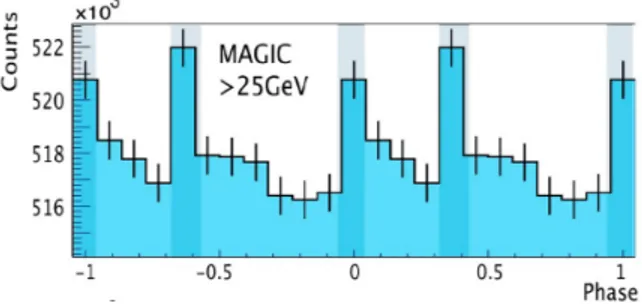1
Recent results on galactic sources with MAGIC telescope
R. De los Reyes for the MAGIC collaboration
aa
Volltext
a
Abbildung
![Figure 1. Smoothed sky map of LSI +61 ◦ 303 above 400 GeV around the periastron passage (left) and at orbital phase 0.4-0-.7 (right) when the maximum emission is observed [1]](https://thumb-eu.123doks.com/thumbv2/1library_info/4011192.1541146/2.918.485.806.525.688/figure-smoothed-periastron-passage-orbital-maximum-emission-observed.webp)

ÄHNLICHE DOKUMENTE
The emission of 1ES1959 was studied as a function of time and the results are presented in the light curve in figure 7.4 and 7.5 together with the mean integral γ-ray flux of the
A spectral and tempo- ral analysis of the 24 observation nights puts special emphasis on two nights, dur- ing which high flux levels exceeding three times the Crab nebula flux
The Crab nebula spectrum as measured with MAGIC is also shown (gray dotted curve; small gray numbers indicate the fraction of Crab nebula flux for the 1ES 2344+514 flux points) and
The current tightest constraint on the > 100 GeV emission from the pulsar and its nebula, obtained by the Whipple collaboration [5], puts an upper limit of 75 GeV on the
1 (right) show the significance calculated in bins of (0.1x0.1) degrees 2 for events with energies above 200 GeV, and the derived upper limits on the integral γ -ray emission. From
The resulting fit parameters are shown in the insets of the middle and right-hand plot of Fig. 1, showing flux-doubling times of the order of 2 minutes. This is the fastest
A total of 22 hours of observation of the Crab pulsar has yielded a signal at 6.4 σ in the same phase bin as that of the EGRET measurements and simultane- ously with the optical
Later on, observations by Fermi-LAT have shown that the the Crab pulsar energy spectrum up to 30 GeV can be described with a power law with an exponential cutoff at 6 GeV,